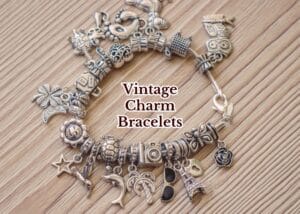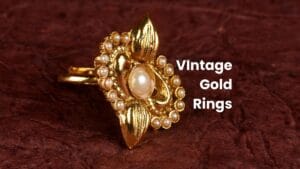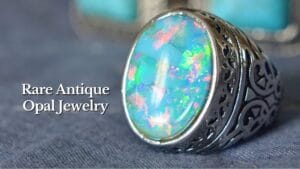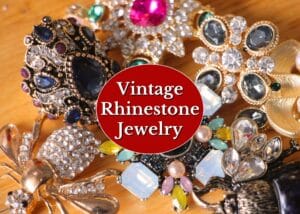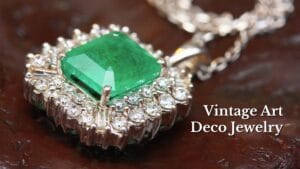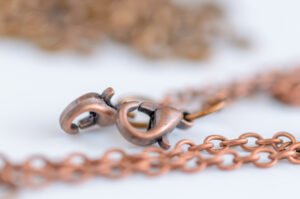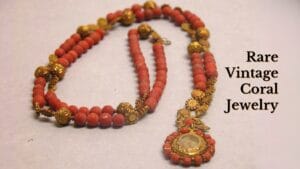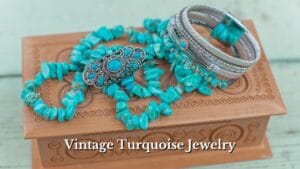Charm bracelets are thousands of years old, but they were used as talismans and spiritual tools, not fashion statements. Queen Victoria changed everything in the 1800s, using them as romantic keepsakes with photos and hair from loved ones!
After this, charms became popular, especially among girls. But today, it’s everyone’s favorite as a hot collectible. A piece that was once bought for $10 could now be worth $1,000 or more!
In this guide, I’m going to share everything about vintage charm bracelets. With this, you’ll learn what exactly to look for, how to spot the valuable pieces, and why some of the charms sell for hundreds of thousands of dollars!
Spotting Vintage Charm Bracelets (Key Signs of Age & Authenticity)
While charms remain popular today, vintage pieces display early craftsmanship that modern people, especially collectors, love. But most people struggle to spot a real vintage charm bracelet!
Below are some factors and signs that will help you identify whether or not a charm bracelet is actually an antique!
Materials
What a vintage charm bracelet is made of speaks a lot about its age and authenticity! Observe the base materials (the setting) as well as the materials of the charms!
Base Materials:
From gold to brass and pewter, many different base materials have been used to make charm bracelets since their popularity in the 19th century. Here’s what different materials tell you:
- Gold: This is the most common material for vintage charm bracelets! Real gold pieces feel heavier and have a richer color. Also, real gold won’t stick to a magnet and shows gentle wear on high-contact areas over time.
- Sterling Silver: Sterling became a popular choice for affordable bracelets, especially from the 1950s onward. Pre-1920 pieces are often unmarked but made of high-quality silver (develops patina); post-1920s pieces have hallmarks to identify them!
- Gold-Filled: Many vintage pieces are gold-filled – a thick gold layer bonded to base metal! Although not solid gold, these are still legitimate vintage pieces with solid construction.
- Platinum: Although extremely rare, some pieces 1920s-1940s may be platinum. Platinum is heavier than gold (white) with a cool white color that never changes. Since most vintage Platinum jewelry was melted for the war effort, these are rare!
- Base Metals (Red Flags): Brass and pewter were used in later reproductions and budget pieces. These feel noticeably lighter than precious metals and often have yellowish or grayish tints. Modern reproductions often have perfect, overly shiny finishes that lack authentic aging.
Gemstones:
Stones used in a charm bracelet can also help you identify and date it.
For instance, Garnets, Corals, and Seed Pearls are highly common in Victorian bracelets. Jet is commonly seen in Victorian mourning pieces. If you see a lot of turquoise, it’s likely a Native American and Southwestern-influenced piece.
Diamonds are common for Edwardian and Art Deco bracelets, especially in rose cuts or old European cuts. The Art Deco pieces (1920s-1940s) also feature a lot of colored stones, like Emeralds, sapphires, and rubies in geometric step cuts or baguette shapes!
Era-Specific Designs
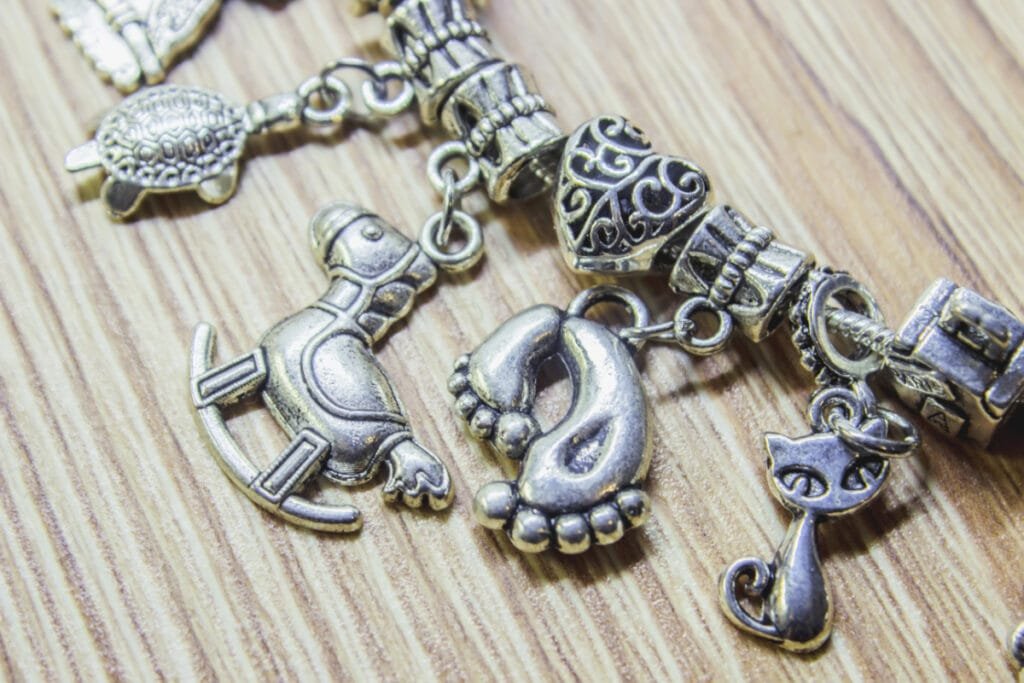
Like other jewelry pieces, charm bracelets also underwent changes with time, with each significant era having its influence on the design and elements.
Victorian Era Charms (1837-1901):
Victorian charms are all about romance and sentiment. You’ll see lots of hearts, flowers, bows, and lockets. If someone in the family died, they’d add mourning charms—usually black jet or pieces that held hair.
The metalwork in Victorian charms is highly ornate! Everything was hand-engraved and incredibly detailed. Religious symbols were huge too, along with sweet little inscriptions like “Forever Yours” or “Remember Me.”
Art Nouveau Bracelets (1890-1910):
French Art Nouveau was usually made in 18K gold and featured beautiful French sayings with floral motifs.
Look for phrases like “A Vous Toujours” (Always Yours) or “Je Porte Bonheur” (I Bring Happiness). The enamel work—called plique-à-jour—is stunning. It looks like stained glass.
Art Deco Charms (1920-1935):
Charm bracelets from the Art Deco era are all about geometric shapes, clean lines, and modernity. These generally feature stylized animals, airplanes, cars, famous landmarks (with increasing popularity for travel themes), or abstract designs.
Besides, enameling, especially in bold colors like black, red, and green, is a hallmark of Art Deco charms.
Mid-Century/Retro (1940s-1960s):
Many experts call this the golden age of charm bracelets. The themes from this period are vast and often whimsical, reflecting post-war scenes and rising consumer culture. Mechanical charms with moving parts are a classic feature of this era.
Look for charms related to travel (suitcases, landmarks), hobbies (skis, artist palettes), family life (baby shoes, houses), and popular culture.
Construction Clues
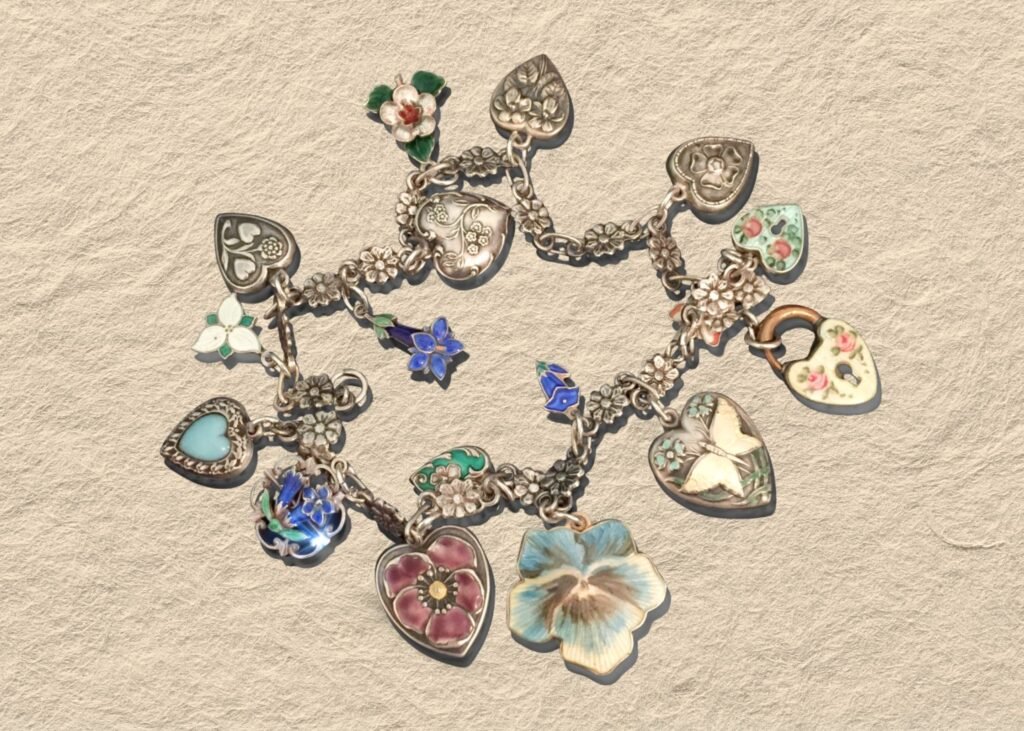
While those tiny construction pieces, like the chain, clasp, and rings, almost go unnoticed, they can tell plenty about their background, almost as much as the charms themselves.
Chains
Pay attention to the chains – those in real vintage bracelets feel heavy and solid. Also, Victorian and Edwardian chains often have slight irregularities because they were hand-forged. If you see simple link patterns and snake chains, they’re early pieces!
By the 1920s-1940s, machine-made chains with high precision became popular, and double-link chains gained popularity. The later period of the 1950s to the 1970s brought heavy curb chains and rope chains – all perfectly consistent, a key sign of modern pieces.
Clasps
If you see hooks, ribbons, or simple slide mechanisms in a charm bracelet, it’s likely from the pre-1900 era. The tongue clasp—where a spring-loaded piece fits into a slot—became popular around 1800 and continued through the Victorian era.
Box clasps with slide-lock mechanisms (where you push a little tab and the clasp slides into a slot) are common in charms from 1900-1950.
The 1970s brought the Lobster claws, later followed by uniform flat levers. So, if you see a lobster claw on what’s claimed to be a “1940s charm bracelet,” it’s a red flag!
Soldered Jump Rings
A key sign of a quality vintage piece is that the jump rings connecting the charms to the bracelet are soldered shut. This indicates the charms were meant to be permanent additions and not easily lost.
Makers’ Marks & Hallmarks
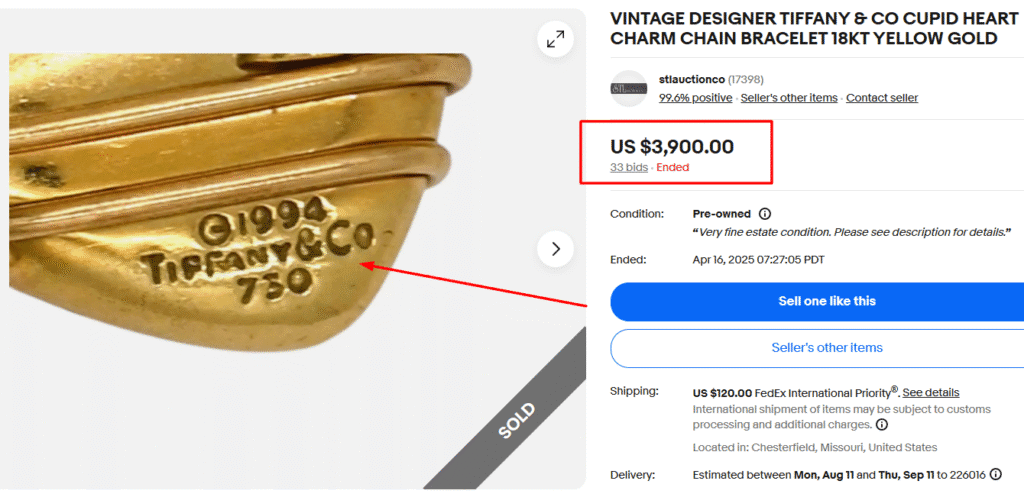
Original markings, such as makers’ marks, hallmarks, or manufacturing year, are one of the most reliable signs to authenticate a vintage bracelet. So, always look for stamped marks on your bracelet and all its charms.
Generally, you’ll find the following markings:
- Purity Marks on Precious Metals: You should see things like “10K,” “14K,” “18K” or “750” for gold, or “STERLING” or “925” on Sterling silver bracelets. Gold-filled pieces will generally have “GF,” “Gold Filled,” or fractions like “1/20 12K.”
- Brand/Maker’s Name: Many companies also stamped their names or initials along with the copyright mark on the charms. The marking style of logos and names can tell a lot about the piece’s age.
- British Hallmarks: If you see a lion, Britannia, or similar unique symbols, it’s a British piece with British hallmarks! In fact, different cities had different symbols, too: an anchor for Birmingham, a castle for Edinburgh, a leopard’s head for London.
You can learn more about vintage jewelry hallmarks here!
What Makes an Old Charm Bracelet Valuable?
One this is obvious, not all vintage charm bracelets attract the same value; some are just more valuable than others due to several factors, like condition, rarity, and quality.
Let’s understand how to assess these factors to see whether or not your charm is worth it!
Rarity
Rarity is the most crucial aspect of value; the rarer a charm, the higher it’s valued! You can find out a rare piece by tracing the following features:
- Limited Production: Vintage charms made in small runs by high-end makers are super rare. Similarly, experimental designs that never went into mass production fetch high returns. Collectors also like custom bracelets that were made for certain clients.
- Unique Design Elements: Pieces with unusual design elements are quite desirable. Look for movable/functional charms (typewriters with moving carriages, windmills with spinning blades, etc.) and conversion pieces (made with stick pins)
- Unique Themes: Generally, a bracelet where all the charms stick to a single theme (like travel, music, occupations) is often more desirable than a random assortment. But certain themes are more collectible than others, for example, travel charms.
- Rare Materials: Charms with rare materials are more popular than those with common materials. As an example, Art Nouveau plique-à-jour enamel work, which requires incredible skill, can make a bracelet worth a premium price.
Metal Quality & Stones
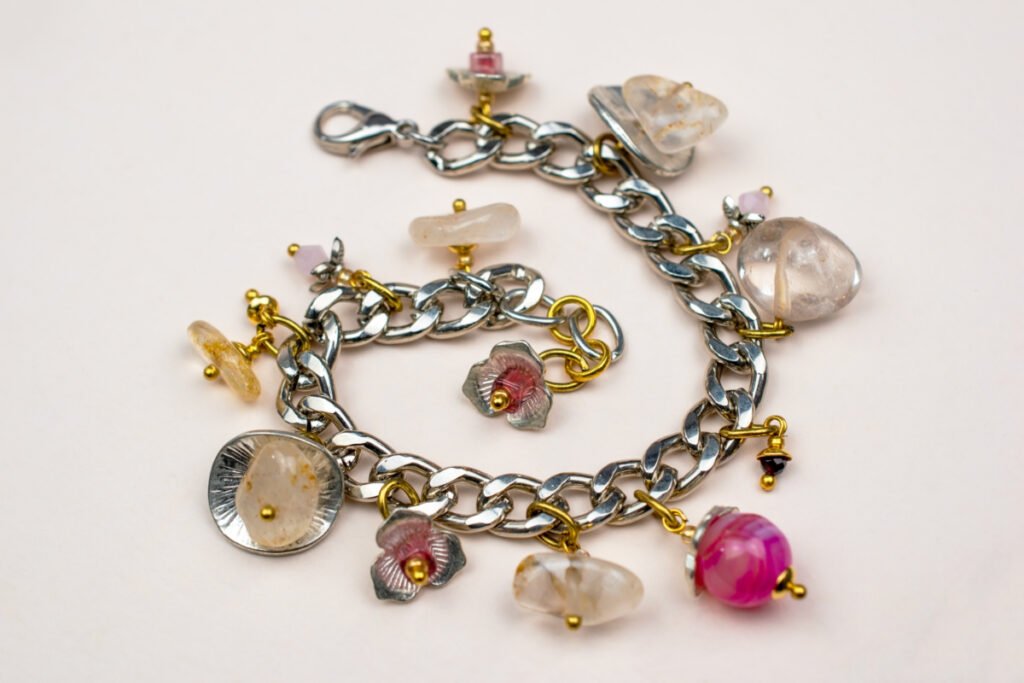
The quality of material (metals or non-metal) and stone used in a charm bracelet is a huge value factor. Naturally, pieces made with higher-quality precious metals will be more valuable.
Platinum pieces, for instance, from the 1920s to the 1940s are extremely rare and valuable, as platinum jewelry from this era itself is quite rare. Similarly, 18K+ gold pieces will command premiums over 14K or 10K pieces.
The same goes with silver pieces; Sterling pieces may have comparatively less value than those made of purer 95.8% silver.
If a charm has stones, some other factors also come into play. Pre-1920s stones are almost certainly natural and, hence, more valuable than synthetic gems. Precious stones, like diamond, coral, turquoise, opal, rhinestone, and ruby, can make charms expensive!
The size and quality of the stones matter, too! So, if a collector wants to pay more for a bracelet with large, natural turquoise than for one with tiny diamonds, don’t be surprised!
Condition
Collectors pay keen attention to vintage jewelry’s condition, and so should you! Assess the charms’ condition rightly, as a piece with significant damage may not be a big deal.
Let me make it easy for you! If you notice the following features, you’re looking at a fine piece:
- All original charms present and properly attached
- Clasp works smoothly and locks securely
- Minimal wear to chain links
- Clear, readable hallmarks
- Original patina intact (not over-polished)
On the other hand, the following are the signs of wear and tear and mishandling that can cut down the worth of a bracelet:
- Missing charms (unless you can document what was there)
- Worn-out or missing clasp
- No markings at all
- Polished away Hallmarks
- Signs of replating
Completeness
Completeness doesn’t mean just a bracelet with all charms intact. It means finding a bracelet with other accessories, like the box, case, or pouch.
Original presentation boxes are incredibly rare, as most are lost or broken. So finding a bracelet in its original box is like hitting a jackpot! This matters more if the piece is from a renowned brand like Cartier, Tiffany, or Van Cleef.
Similarly, documentation is golden. Look for original receipts, family photos showing the bracelet being worn, even handwritten notes about individual charms—all of this adds to the story and the value.
10 Examples of Rare Vintage Charm Bracelets Worth Money
Now that you know how to spot a real piece of art, let’s understand how the factors mentioned above really impact the worth with the following examples!
1. Full 14k Yellow Gold Charm Bracelet with 17 Charms
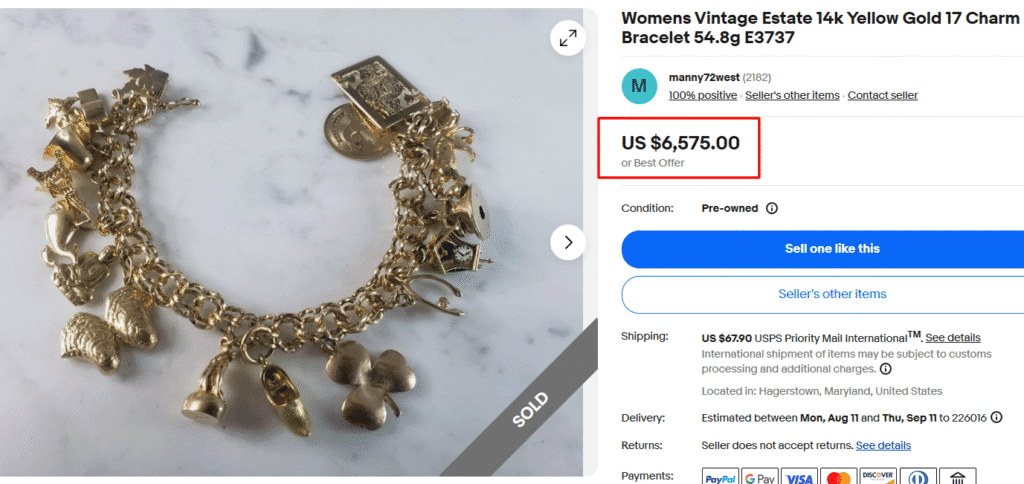
This piece is a real collector’s dream; no wonder it sold for over $6,500! This features seventeen different charms hanging from a solid 14k gold bracelet that weighs almost 55 grams. Each charm, ranging from a little Eiffel Tower from a Paris trip to a graduation cap, or a tiny baby shoe, tells a different story.
While single-theme charms are more popular, such estate pieces with random charms are also special because they represent someone’s whole life collected on one bracelet. Besides, the high-quality hallmarked gold setting brings the real value!
2. Van Cleef Arpels Alhambra Blue Agate Gold Bracelet
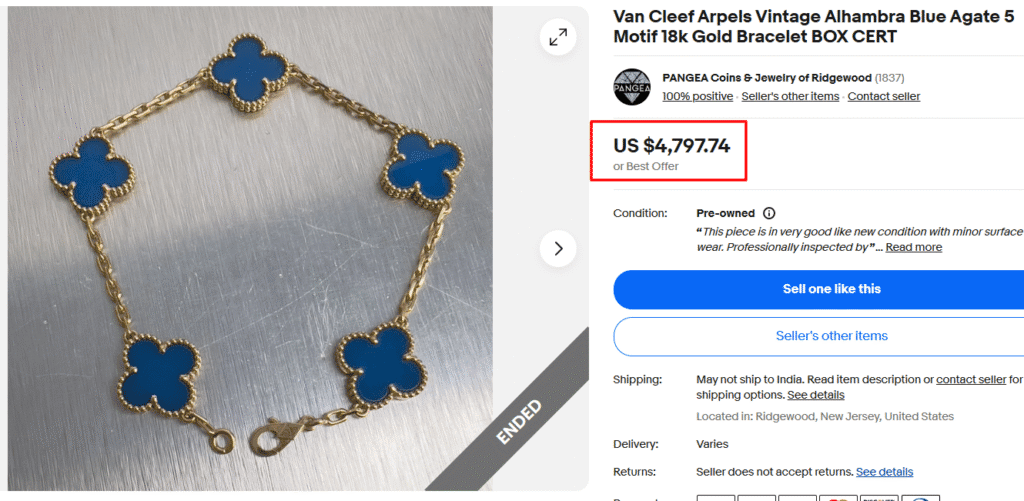
This vintage Van Cleef charm bracelet has those four-leaf clovers (they call them “Alhambra”), which are believed to bring good luck. Also, each clover is made from 18k gold with beautiful blue agate stone centers and tiny gold beads around the edges.
Van Cleef & Arpels is one of those fancy French jewelry houses that is quite popular among celebrities and fashion jewelry collectors; no wonder it reached a whopping $4,780!
3. Vintage Tiffany Golden Heart Charm Bracelet
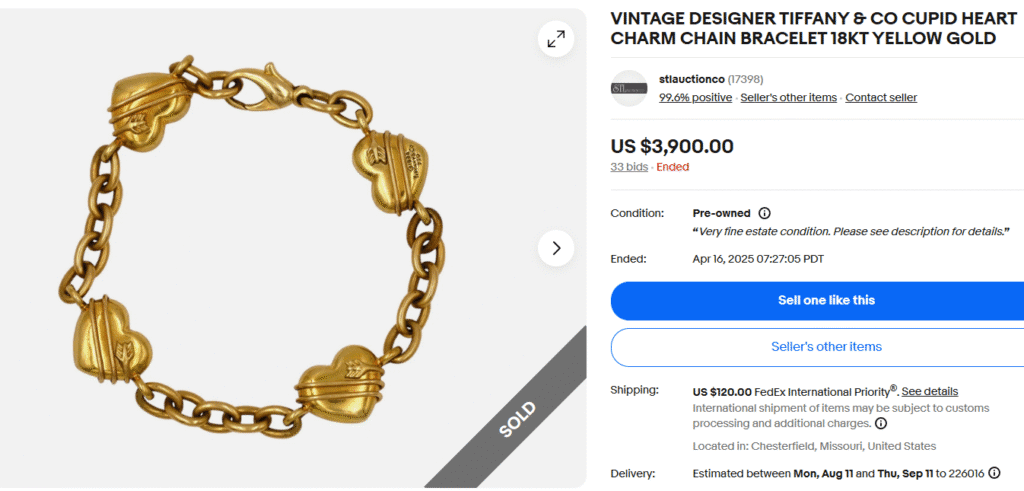
This gorgeous Tiffany charm bracelet is made from real 18k gold and features the iconic cupid heart design (heart wrapped by an arrow)- classic Tiffany romance! You will find the “Tiffany & Co.” and gold hallmarks on this piece, along with the copyright and date marks.
Also, this bracelet will have a single-link chain and a lobster claw clasp. This piece is a classic example of Tiffany’s high-quality jewelry, making it worth the steep price tag of $3,900!
4. Sterling Silver Puffy Heart Charm Bracelet
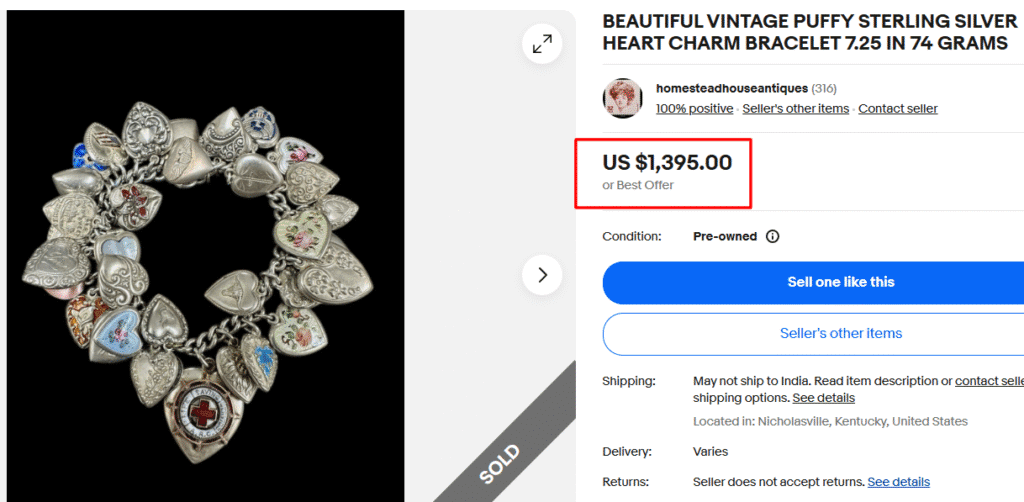
This chunky, puffy heart charm weighs a whopping 74 grams! Made of Sterling silver, those puffy hearts feature the iconic “répoussé” hearts (design technique) that were super popular back in the day.
Each charm has intricate, tiny details carved into it, while some even have colorful enamel or little gems. This kind of themed, puffy, and substantial charm bracelet with a lot of charms is quite desirable, especially with high-quality material like Sterling!
5. Navajo Zuni Sterling Coral Turquoise Bracelet
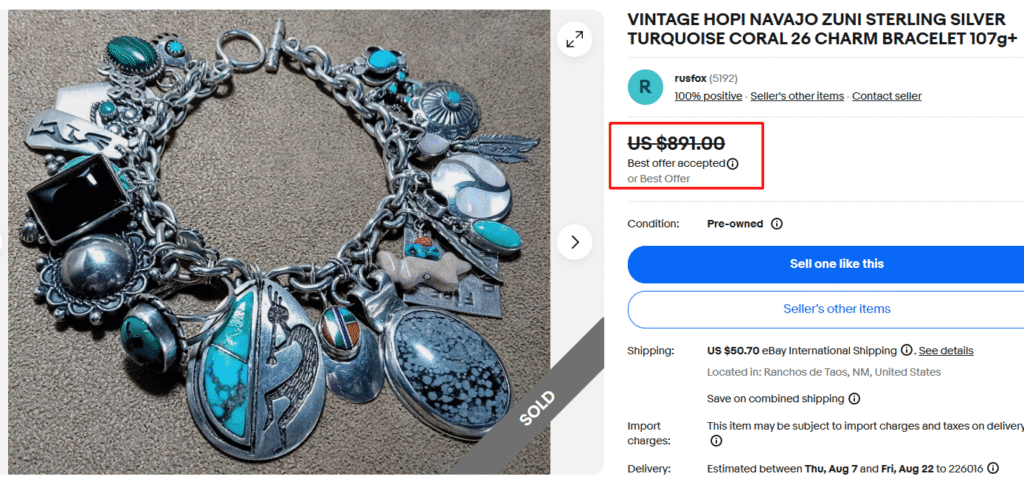
This antique charm bracelet is rare because it reflects authentic Native American craftsmanship from three different tribal traditions — Hopi, Navajo, and Zuni.
Each tribe is popular for their special techniques: Navajo artists for their beautiful silver work, Zuni masters for amazing stone inlay, and Hopi artisans for the gorgeous overlay style. And you’ll find all of it in this bracelet.
Besides, it has different types of turquoise stones as well as coral stones, traditional materials used in Native American jewelry for centuries. You can authenticate this antique piece by the hallmarks, like Sterling, .925, M.K.M. pictograph logos, Victor V., and W B, G!
6. Triple Loop Prong Style 14K Gold Charm Bracelet
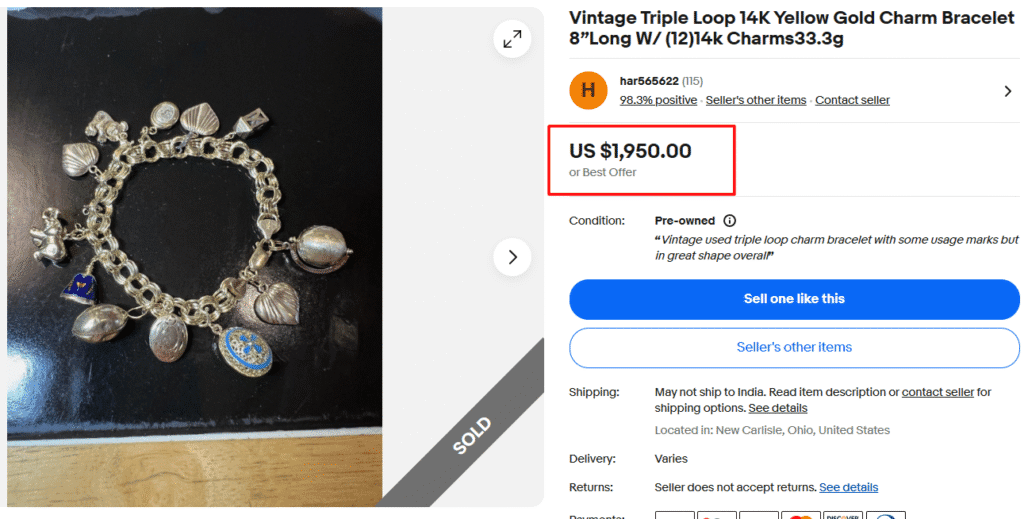
This is a rare 14K gold vintage charm bracelet with the unique “triple loop,” which means the chain has three rows, so it looks extra bulky and feels quite heavy! Thanks to the gold content, this piece will have a substantial weight (specifically around 30 grams)!
The bracelet has 12 different charms hanging from it, ranging from seashells and elephants to hearts and a globe! The solid amount of 14K gold and the variety of charms are what drove the value here!
7. Richard Klein 10K Gold Victorian Revival Bracelet
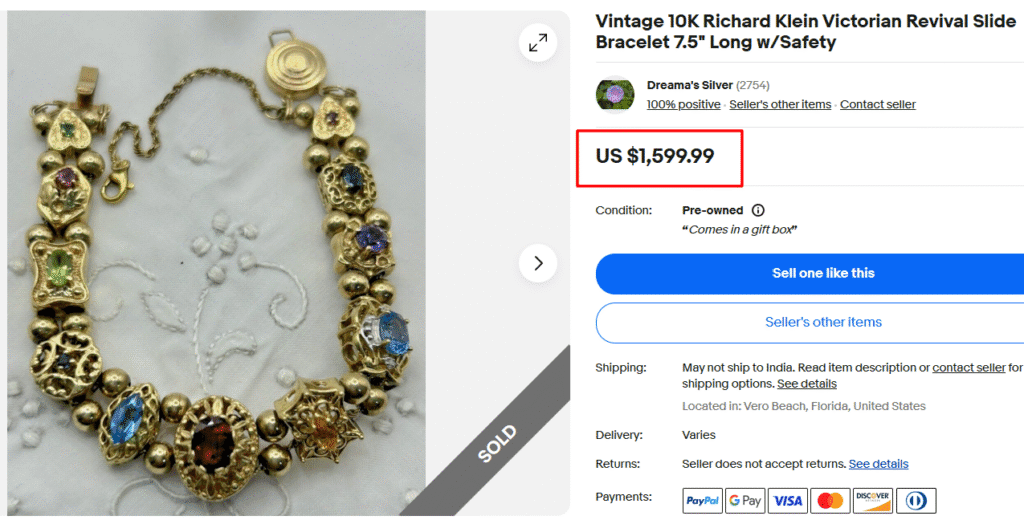
This is a vintage “slide bracelet!” While charms in regular bracelets are fixed, this one has these beautiful little slides or charms that move along the chain. And Richard Klein was famous for making these Victorian Revival pieces back in the day.
This piece was bought for a stunning price of almost $1,600! The reason? It’s got colorful gemstones like amethyst, garnet, and citrine set in 10k gold. I know, while 10K gold itself isn’t that valuable, it’s the stones that boost its price!
Plus, Victorian Revival jewelry from the mid-1900s is super hot with collectors right now. So finding a charm in good condition with all the original stones is pretty rare.
8. James Avery Bracelet With Unique Retired Charms
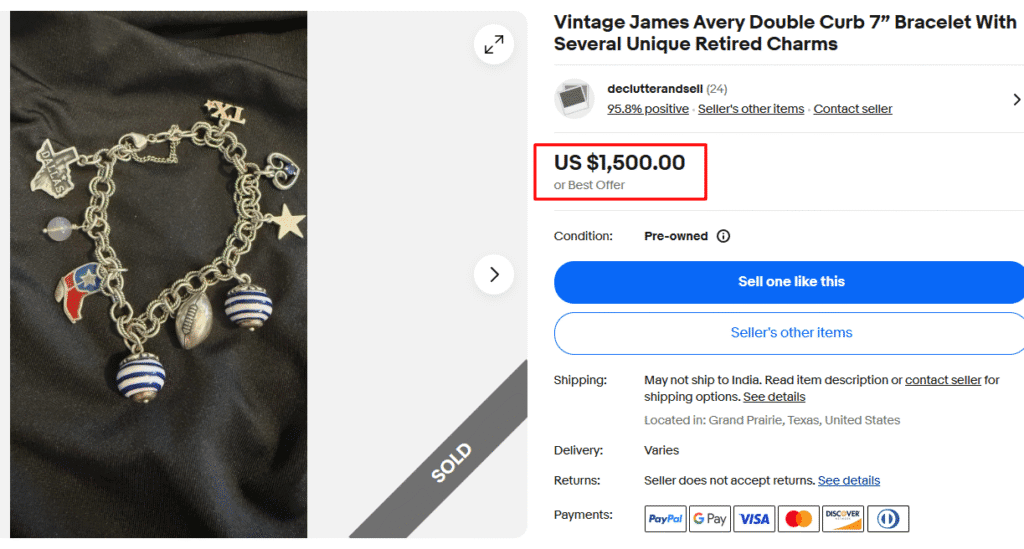
Finding a James Avery charm is a collector’s dream, especially one like this! It features the unique double curb chain, a true example of Avery’s classic style.
What makes this piece even rarer is that it’s loaded with retired James Avery charms you can’t find anymore, including a Rugby ball, a star, a TX, and a Dallas charm!
Collectors are literally crazy for James Avery’s discontinued charms, especially when they’re in great condition! That’s why one bought this piece for over a thousand dollars!
9. Vintage Multi-Gemstone 10k Slide Charm Bracelet
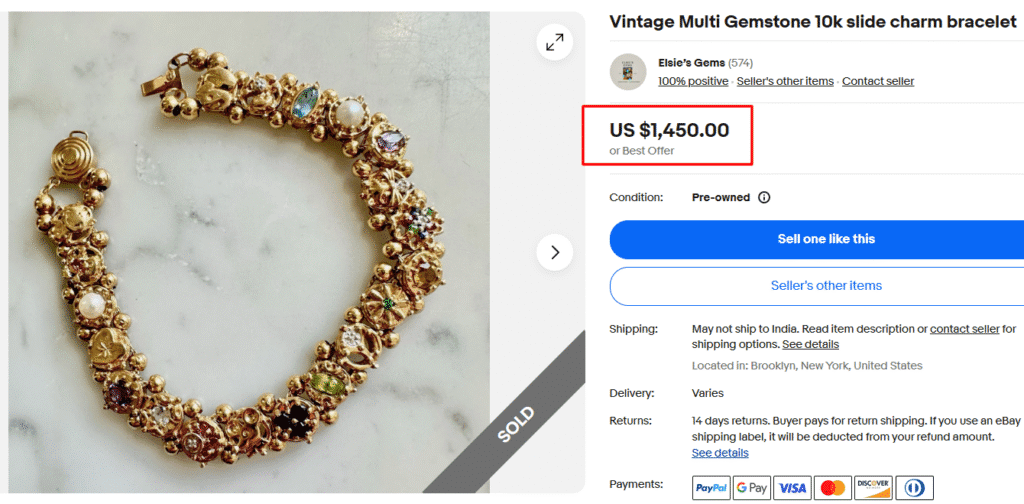
This is a highly ornate bracelet absolutely loaded with colorful gemstones set in solid 10k gold slides. You can spot amethyst, citrine, garnets, pearls, and what looks like emeralds all nestled in individual gold settings.
Slide bracelets were hugely popular from the 1880s through the 1950s because they let you arrange your “slides” however you wanted. This unique feature, combined with many desirable stones and 10k gold work, is what makes this piece worth the steep price of $1,450!
10. Alice in Wonderland Sterling Intaglio Bracelet
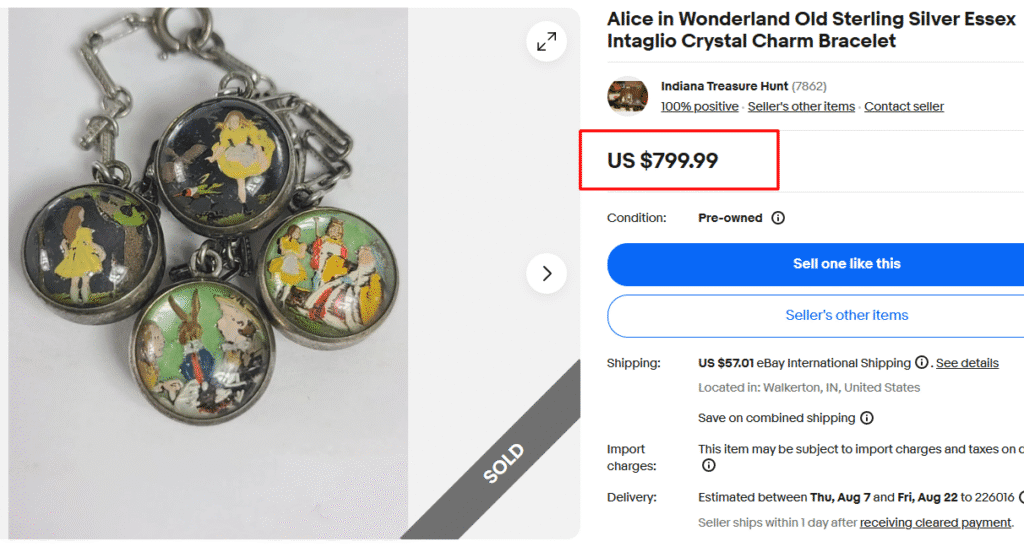
There are so many things that make this charm unique! First, it’s a Disney-themed piece based on everyone’s favorite, Alice in Wonderland! Second, it features something really special called “Essex crystals!”
What’s that? Well, each crystal is hand-carved and painted on the back in reverse, so when you look through the front, the Alice in Wonderland characters appear to float inside like tiny 3D scenes.
This complicated technique started back in the 1860s in Belgium and was crazy popular during the Victorian era. You’ll see Alice, the White Rabbit, and other characters from the story painted with extremely thin brushes – a true piece of art!
Note: This article is intended for informational, educational, and entertainment purposes only. Some images are illustrative and may not represent actual brands, products, or related entities. All trademarks, product names, brand logos, packaging, and other intellectual property referenced remain the exclusive property of their respective owners. Any brand mentions or references are provided solely for descriptive and educational context and do not imply any formal or commercial association.

